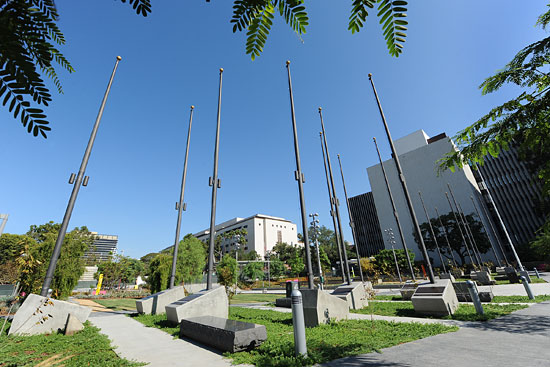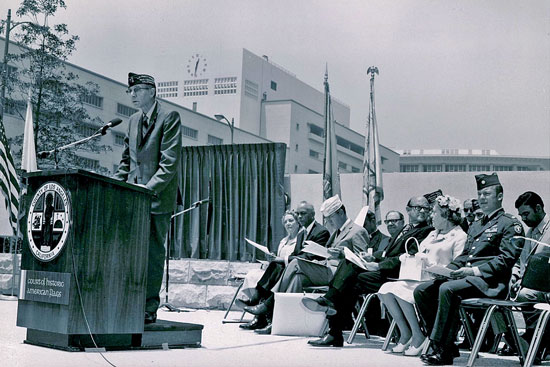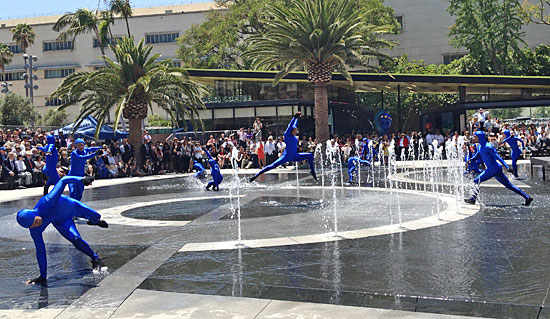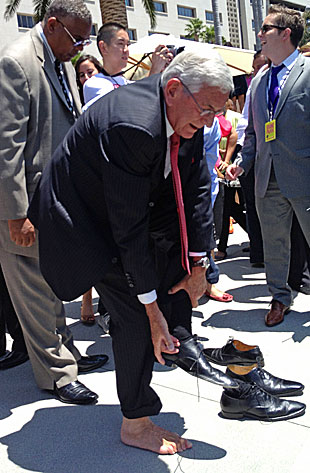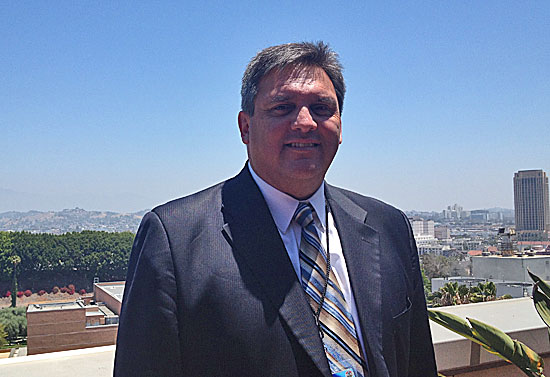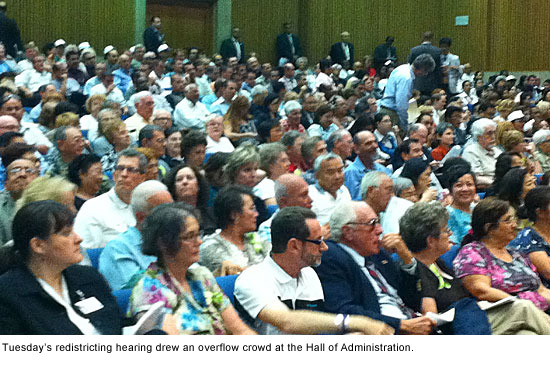The grandest opening of them all
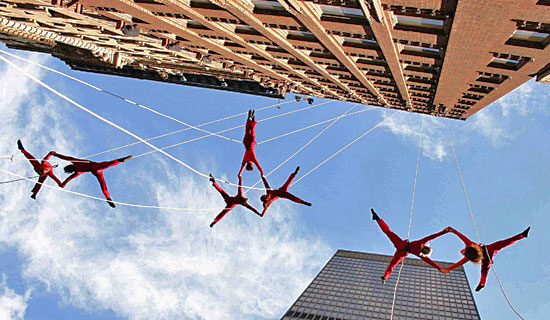
Bandaloop brings its aerial artistry to City Hall on Saturday, for the opening of Grand Park’s final segment.
It’s been rolling out, bit by bit, since mid-summer, but this weekend, Grand Park will finally get the grand opening Los Angeles has been waiting for.
As the third and final section of the 12-acre space opens to the public, a festive block party is being planned on Saturday, October 6, from 4 p.m. to 9 p.m., with dancing around the fountain, Cuban jazz on the lawn, food trucks on the street and, at the park’s eastern boundary, a soaring aerial ballet up the sides of L.A.’s iconic City Hall. Then on Sunday, the park will leap into action as a hub for the wildly popular CicLAvia.
“It’s really exciting,” says Dawn McDivitt, who has managed the park project for the county’s Chief Executive Office. “The opening of the first two blocks in July drew 5,000 people in the first weekend, and we think this weekend will draw even more.”
Stretching from City Hall to the Music Center, the new park—an inviting 4-block rectangle of grass, plants, water and hot pink lawn chairs—has been drawing crowds since its first segment opened this summer, offering the first substantial stretch of green space in downtown L.A.
Conceived nearly a decade ago as part of a plan to redevelop Grand Avenue with luxury hotels, condos and retail, the park moved ahead while other elements were postponed by the economic downturn, largely because of a $50 million payment that was negotiated upfront from Related Cos., the project’s developer.
The first section, opened in July, is anchored by a Starbucks and the Arthur J. Will Memorial Fountain, which features an ankle-deep membrane pool that has become a major weekend draw for nearby families. The middle section features a community terrace with a Court of Flags, a Vietnam Memorial and 24 cherry blossom trees from the Japanese Consulate. The final section, at the City Hall end, will offer a dog park and a spacious event lawn that planners already are programming for local gatherings. Also on tap for the future is an anchor restaurant or café at the City Hall end of the park.
“I think if you ask anyone, the park is already a success,” says McDivitt, noting that none of the park events so far have drawn fewer than 200 to 300 people. “And when you compare that to the mall that was there before, where, if you saw 20 people in all three blocks, you were lucky—just looking out my window at the Hall of Administration, it’s amazing. People who have driven in from their communities for events, neighborhood people from the lofts, mothers sitting around the membrane pool with their children. There are more people than I’ve seen down there in 22 years of working here.”
This weekend’s kickoff is expected to draw crowds from throughout the county, starting with 11 a.m. dance lessons at the Music Center Plaza in a salute to Latino Heritage Month.
At 4 p.m., the Grand Park celebration will officially begin with “A Fanfare for Grand Park,” a reprise of a dance performance that premiered at the park’s July dedication.
At 5:30 p.m., down the hill on the park’s performance lawn, the Latin jazz duo Dos y Mas will launch the park’s new World Jazz Series, and at 6:45 p.m. outdoor videos will be projected onto the wall of the county’s Richard Neutra-designed Hall of Records building that flanks the park.
After a welcome from public official and dignitaries, the party will move to the event lawn. There, at 7:45 p.m., the aerial dance troupe Bandaloop will perform a spectacular vertical dance on the walls of the city’s towering City Hall building, suspended hundreds of feet off the ground by climbing ropes.
Park officials view Saturday’s celebration as just the start of Grand Park’s new role as a downtown centerpiece. Programming will be handled for the first three years by the Music Center, and Park Director Lucas Rivera has predicted the park will soon be home to farmers’ markets, arts festivals, book fairs, and other regional gatherings. McDivitt says she won’t be surprised to see regular movie nights, with outdoor films projected on the Hall of Records. Already, one segment of the park is home to the downtown speakers’ series Zócalo.
Events scheduled for the near term include an October 14 Pooch Party for dogs and the people who love them on the event lawn, an October 27 performance by the AXIS contemporary dance company, a November 2 night time Dia De Los Muertos party and a November 4 arts happening called Flash Fest.
Says McDivitt: “This really is a brand new chapter for downtown L.A.”
Posted 10/4/12



